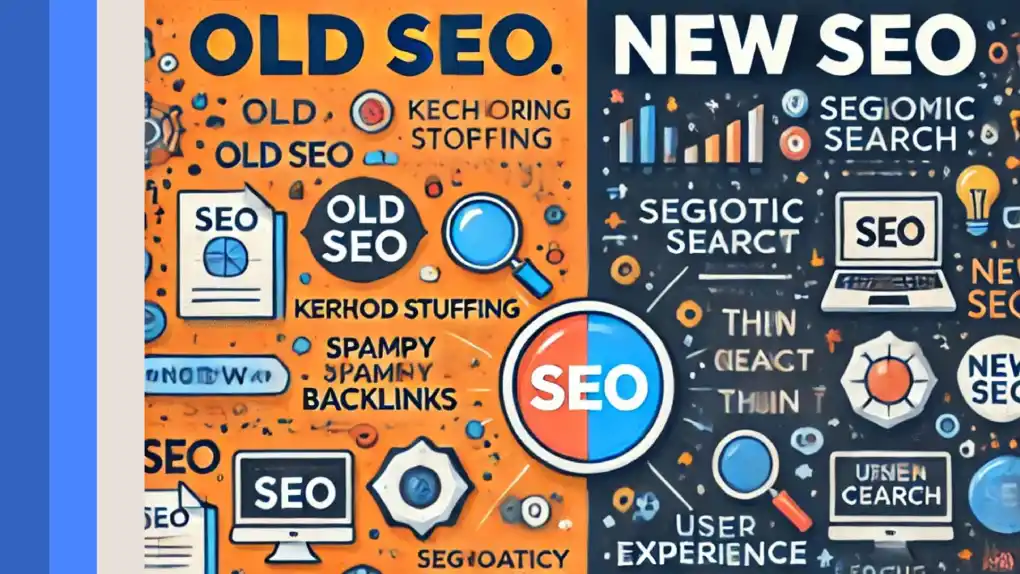In the ever-evolving world of search engine optimization, understanding what is old SEO and new SEO can be the key to sustainable online success. Old SEO (often called “traditional SEO”) refers to outdated tactics focused heavily on quick fixes and search engine manipulation. By contrast, new SEO (or “modern SEO”) prioritizes user experience, high-quality content, and genuine authority building.
What Is Old SEO and New SEO: Key Insights
Discover useful information on what is old SEO and new SEO. This section outlines how traditional SEO tactics—like keyword stuffing, low-quality backlinks, and thin content—have evolved. It contrasts outdated practices with modern, user-focused strategies that emphasize quality content, semantic optimization, and sustainable growth, offering essential insights for building a robust digital presence.

Here’s a comparison table highlighting the key differences between Old SEO and New SEO:
| Aspect | Old SEO | New SEO |
| Keyword Usage | Focused on exact-match keywords and stuffing them into content | Uses semantic search, synonyms, and natural keyword placement |
| Content Quality | Thin, low-value content created mainly for search engines | High-quality, user-centric content that provides value |
| Backlinks | Mass link-building with low-quality or spammy backlinks | Earns relevant, high-authority backlinks through quality content |
| User Intent | Ignores search intent, focuses only on ranking | Aligns with user needs, providing helpful and relevant content |
| Mobile & UX | Not optimized for mobile or user experience | Prioritizes mobile-friendliness, fast loading, and UX |
| SEO Strategy | Short-term gains with manipulative techniques | Long-term strategy focusing on credibility and trust |
| Algorithm Impact | Vulnerable to search engine penalties | Follows Google’s guidelines and best practices |
Old SEO: A Snapshot
- Keyword Stuffing: Pages were overloaded with exact-match keywords, often sacrificing readability.
- Low-Quality Backlinks: The goal was to get as many links as possible, even from irrelevant or spammy sites.
- Thin Content: Short, repetitive articles were published in bulk, hoping to rank quickly for specific terms.
- Ignoring User Intent: Old SEO prioritized technical loopholes, not the actual needs or questions of users.
New SEO: The Modern Approach
- User-Centric Content: High-value, engaging articles answer real questions and solve real problems.
- Quality Over Quantity: Building authoritative backlinks from trusted sources matters more than sheer volume.
- Semantic Optimization: Natural use of synonyms, related keywords, and topic clusters to satisfy search intent.
- Sustainable Growth: Focusing on brand credibility, long-form content, and genuine audience engagement leads to long-term results.

Why the Shift Happened
Major search engines like Google rolled out algorithm updates (e.g., Panda, Penguin, and Hummingbird) to discourage spammy practices and reward valuable, user-friendly websites. As a result, old SEO methods—stuffing keywords or buying low-quality links—often lead to penalties. Meanwhile, new SEO strategies prioritize depth, relevance, and trustworthiness.
Conclusion
Ultimately, what is old SEO and new SEO boils down to intent and execution. Old SEO targeted search engines alone, while new SEO balances technical best practices with user satisfaction. By embracing fresh, quality-driven tactics, brands not only avoid penalties but also establish lasting online authority.
FAQs
Old SEO refers to traditional tactics such as keyword stuffing, mass-produced low-quality content, and the acquisition of irrelevant backlinks that were once used to manipulate search rankings but often led to penalties.
New SEO is a modern, user-focused approach that emphasizes high-quality, engaging content, semantic optimization, and building authority through relevant, trustworthy backlinks, ensuring long-term success and a positive user experience.
Search engines like Google have continuously updated their algorithms to reward genuine value and user satisfaction. This evolution penalizes outdated tactics and encourages strategies that improve user experience and deliver meaningful content.
Start by auditing your current practices, then focus on creating in-depth, original content, optimizing for semantic relevance and user intent, and building high-quality, authoritative backlinks. Consistently monitor your performance with tools like Google Analytics and Search Console to adjust your strategy.





